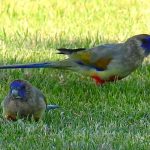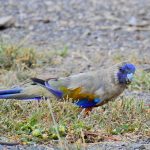BLUEBONNET
Bluebonnets are found primarily in the arid and semi-arid regions of eastern and south-eastern Australia. They inhabit open woodlands, grasslands, and scrublands, often near water sources. These birds are particularly prevalent in New South Wales, Queensland, South Australia, and Victoria.
Bluebonnets are known for their vibrant plumage, which includes shades of blue, red, and green. The amount of blue on their wings and back gives them their name. They are highly social birds, often seen in small flocks outside the breeding season.
They are excellent mimics and can imitate sounds and even human speech to some extent. The males can measure up to 35 cm in length with the females measuring to around 32 cm. Their weight varies between 70-100 grams. In the wild, Bluebonnets can live up to 10 years.
Bluebonnets have a varied diet that includes seeds, fruits, berries, and flowers. They are also known to feed on insects and their larvae, providing a balanced diet that supports their energetic lifestyle. These parrots often forage on the ground, using their strong beaks to crack open seeds and nuts.
Breeding season for the Bluebonnet typically occurs from August to December. They nest in tree hollows, where the female lays a clutch of about 3 to 6 eggs. The female incubates the eggs for approximately 20 days, while the male provides food. Once hatched, the chicks are cared for by both parents until they fledge at around 5 to 6 weeks old.
The Bluebonnet Parrot, like many of Australia’s unique species, relies on the conservation of its natural habitat to thrive. Protecting woodlands, grasslands, and water sources is crucial for their survival. By supporting conservation efforts and sustainable land management practices, we can help ensure that these beautiful birds continue to grace our landscapes for generations to come.


